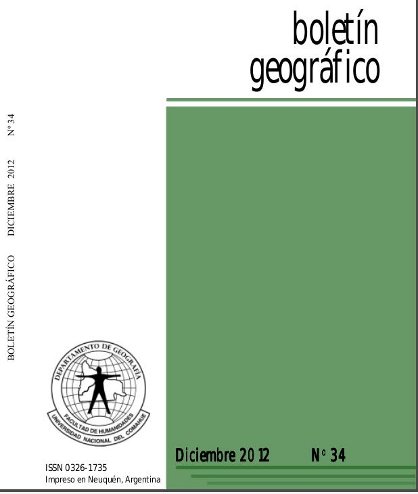Destabilization of slopes and mass removal processes hazards. Study case: slopes of curruhuinca hill. San martín de los andes. Neuquén.
Keywords:
urbanization, hazard, mass wasting, riskAbstract
Abstract
Population growth inevitably leads to the expansion of urban plants and the occupation of areas unsuitable for urbanization.The uncontrolled expansion of the physical area of the cities through residential areas at unsuitable locations often leads to a loss of land and the transformation of the natural landscape. Thus the city understood as a social product in constant transformation that reflects the interaction between natural and social components has become a scene of situations of risk and social vulnerability.
In the town of San Martin de los Andes, Neuquén, Patagonia Argentina; not only have occupied areas that correspond to the Valley glacifluvial but also the mountain slopes of the hills that surround the city from which have generated situations of risk for the population there installed.The study area corresponds to the territorial area which comprised the urban space of San Martín de los Andes: foothills of the Curruhuinca mountain, located to the North of the city of San Martín de los Andes, in sector East, referring to Arroyo Pocahullo, southern slope of the Curruhuinca Hill. From west to east includes the neighborhoods: Calderon, Godoy, July Obeid, South Park, Vallejos and three of cavalry.
Here se is in danger of occurrence of gravitational movements (avalanches of rocks, translational slides, tipping, flows channelled and fall of rocks); the risk of flooding and seismic hazard, the latter in connection with the property that has mass, and therefore as effective trigger movements of removal in the destabilization of the slopes. The fall of rocks, are common in the area, product of the different factors of detonating. Settlers warn of the danger of the detachment of the same, in rainy season; and they demand from the municipality as a possible brake, the construction of retaining walls. The reality is that the slope is very unstable, and the only solution that should be used is the relocation of the entire population.
The process of urbanization has characterized as very dynamic and spontaneous, being built, thus, a disorderly and dismantled social and spatial city. San Martín de los Andes is not outside of that process from the beginning of the 1980s has experienced a great population growth, due to the arrival of immigrants to the area, which were occupying areas unsuitable for settlement. The slopes of the mountain, in this case those of Cerro Curruhuinca, do not constitute a physical constraint. It is necessary to deepen studies of risk on the slopes of the mountains, build public works and increase environmental monitoring, in such a way of mitigating the damage that may occur to removal processes in mass.
Downloads
Downloads
Published
How to Cite
Issue
Section
License
Copyright (c) 2013 Boletin GeográficoTransfer of rights and data processing
The acceptance of an article for publication in the Journal Geographic Bulletin implies the cession of the rights of printing and reproduction, by any means and means, of the author in favor of the Department of Geography of the National University of Comahue, which will not reject any request reasonable for the authors to obtain permission to reproduce their contributions. The total or partial reproduction of the works published in the Geographic Bulletin must be done citing the origin, otherwise, the copyright is violated.
Likewise, it is understood that the concepts and opinions expressed in each work are the sole responsibility of the author, without being responsible or in solidarity, necessarily, neither the editorial staff nor the editorial staff.
It is the responsibility of the authors to be able to provide interested readers with copies of the raw data, procedure manuals, scores and, in general, relevant experimental material.
Likewise, the Management of the journal guarantees the appropriate treatment of personal data
COPYRIGHT TRANSFER FORM


















 Journal of the
Journal of the 